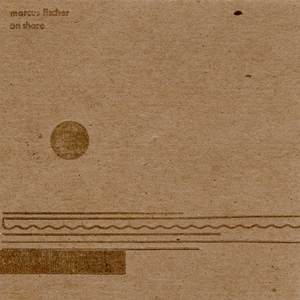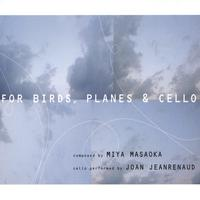Category 5:
Indoors, Pre-recorded Soundscape, Pre-recorded instrument:
A popular category is that of fixed-media pieces that combine the complex sounds of field recordings with traditional instruments, an outgrowth of the electroacoustic tradition. Here composers have the most control in the sonic outcome through many hours spent in the editing studio. There is no visual input in the performance, as the sound sources of the soundscape and instrument are removed from view. Listening in dim light, the audience creates its own reconciliation of the elements.
field recording. The sound of the cello is sustained during the entire piece, blending with the soundscape, particularly the passing planes. The songbirds provide the most active and sporadic layer in the texture, especially at the opening of the track, but Masaoka did not transcribe bird song for the cellist to mimic. Instead, she focused on the man-made bird, so the cello is a sustained long line using double stops and various pitch bends to blend with the frequencies in the recording. Unexpected for me, from this recording of a canyon, the sound of the trajectory of the planes were the most compelling and rich element for me, probably because Masaoka directed my ear with the transcription played by the cello. The simultaneous sounding of the instrument with the field recording created a connection and mimesis in both directions. The cello sounded like the plane, and the plane sounded at times like a cello, or they blended into one. With this combination, the plane became an intriguing instrument! Had she transcribed birdsong, would the planes have become an unwanted interruption in the soundscape? Thus I realized the profound impact the choice made in transcription has on the composition and what role it gives to the functions of the instruments and even the sounds transcribed.
There were also small events, like wind on the microphone, providing tiny beautiful moments in this meditative piece. For Birds, Planes, and Cello is constant in its mood and extremely sustained nature. Reviewer George Varga of the San Diego Union Tribune comments upon the state of mind needed from the audience.
This requires patient listening to appreciate, but those who take the time will marvel at how ingeniously Masaoka can challenge and change perceptions of what is, and isn't, music. By the album's conclusion, Jeanrenaud's piercing extended cello techniques are almost indistinguishable from the bird calls and jet roars they accompany. It's a potent reminder that what matters most in Masaoka's visionary work is the whole, not the individual components, and that intriguing music may be as close as the next hillside or canyon.1
While I insist that the cello is, in fact, distinguishable from the bird calls, Varga does hit the mark stating that it is the work as a whole, the blending of the instrument with the field recording, that makes this album special.
One important element not discussed yet is space. Where does this piece take place? The field recording has a clear origin, but what about the cello? I chose to assign category five to Masaoka's album because both elements are pre-recorded, fixed, and most likely listened to in a sheltered environment indoors. As I listened to the piece on headphones my imagination painted a picture of the canyon with the cellist playing outdoors. Reflecting on the high audio quality and by reading the program notes, I confirmed that the recording of Jeanrenaud's part was done separately in the studio guided by the composer. However, since it is possible to take a cello out into such a setting, my mind was satisfied to create the visual of an imagined live performance to accompany the audio. This reaction was quite different from the mental conflict and schizophonia I experienced during the Christopher Fox piano and field recording piece More Things in the air than are visible..., in large part because the field recording enters after two movements of pure piano music. In Masaoka's work, the instrument and soundscape are ever-present, blend, and thus appear to come from the same place.2 For me, this piece is clearly on the height of contextual-listening, especially since the sound sources are so recognizable and named in the title.
clearly edited, if not processed also, in contrast with the unedited Masaoka recording. Also, rather than a continuous track, there are recurring silences that seem disturbing and shocking in the moment, but they could serve to restart the listener's focus in what could otherwise create an ambient lull. There is one main electric guitar moment, where it is clearly heard above the rest of the texture. I wished to have more of these types of moments, but Fischer focused on a blended approach. Also one can hear a little bit of breathing and movement of the recordist at the end, a small human signature.
1 Varga, George Varga. Review. San Diego Union-Tribune. http://www.miyamasaoka.com/solitaryb/reviews/forbirds.html, accessed February 16, 2016.
2 As a side-note, I wonder if Masaoka notated a score, or whether the cellist listening to the tape is improvising/discovering the sounds herself.
A second fixed-media work for Category Five was composed by multidisciplinary artist and musician Marcus Fischer: On Shore (released 2013). This 29-minute piece combines field recordings, electronic sounds, electric guitar improv, and DIY electronics firmly in the electro-acoustic realm of sound collage. Fischer made the field recording in Manzanita and Portland, Oregon in September, 2012 for original release as a Japanese tour CD. It is not possible to recognize all sound sources, although water plays a prominent part, and the samples were
Miya Masaoka (b. 1958) is a classically trained composer, kotoist and sound artist who composedFor Birds, Planes, and Cello (released 2005), a fixed media piece of a 54-minute field recording with recorded cello. The soundscape of Mission Hills Canyon's birds and overhead planes approaching Lindbergh Field was recorded by San Diego's Marcos Fernandes (Trummerflora collective), and Masaoka invited cellist Joan Jeanrenaud into the studio to record a track over the unedited

